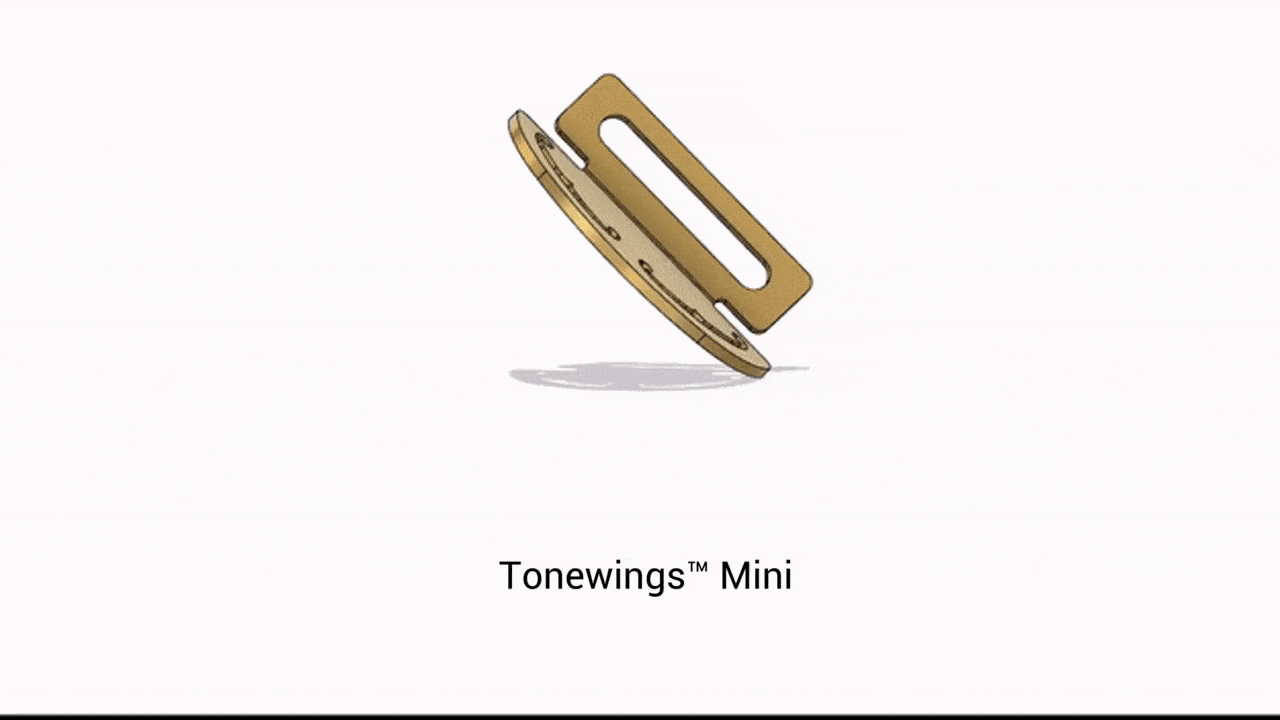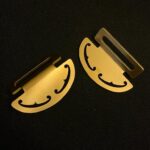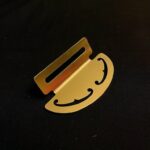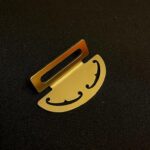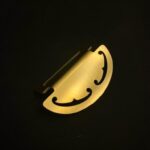Tech Specs
Tonewings™ are universal devices engineered to enhance the acoustic performance of most drums, including custom-made kits, using your existing hardware—no permanent modifications required. Once installed, they can remain in place for the life of your drum, especially when you experience the remarkable improvement in sound. Crafted in two sizes to ensure a precise fit, Tonewings utilize advanced material properties that optimize the vibration transfer between the drum shell and the drumhead. This innovative design helps to reduce unwanted overtones while enhancing tonal clarity and resonance across a wide frequency spectrum. The installation process is straightforward and as simple as replacing a drumhead, requiring no additional hardware. By seamlessly integrating with your drum, Tonewings elevate your sound effortlessly, enabling you to explore new dimensions of musical expression and performance.
…In fact, the
Tonewing actually breaks up the sound wave and/or overtone, making it easier to
identify the actual sonic voice of the instrument. – Kevin Watkins K-Wat drums
The Science behind the tonewings and why they work
The Miracle of Sound Making and Hearing
Miracle #1 (making of sound)
As if without a thought, you abstract musical concepts from concrete things, encode
those abstractions into a drum beat or a rhythm (or a complex drum solo) and fire
neurons in your brain that tell/instruct your trained arm muscles and hands holding the
drum sticks, to construct a pattern of motions with foreknowledge of force, energy and
determination, placement of the drum stick’ tips on the drum head in a series of hits,
passes and combinations (holding all that in a set by your brain to a tempo and volume)
to create a beat, groove, drum pass to form a sound! Hit it….
Miracle #2 (hearing the sound)
The sound reverberates through the surrounding air molecules until those sound waves
enter your and your hearer’s ears, causing their eardrums to flutter and pulse, which
triggers their neurons to fire, thus detecting, decoding, and assigning meaning and the
significance, complexity, or otherwise skill level at which the drum sound is being made.
You’ve effectively shared a musical thought in the form of a drum beat/rhythm with
another soul, all within fractions of moments and with little conscious effort. Not all
miracles are rare.
So, while you could, in theory, model the sound of an instrument to create a perfect
sound, you cannot do this in practice because the problem is just too complex (no, we
still can’t model a violin). Stradivarius and his brethren of top instrument makers used
many of the most powerful computers known to mankind – our own brains – all working
together to find perfection.
THE WHY of Tonewings
Proven scientific physics of multi-frequency resonances, impulse response
filtering, energy transmission, and power leveling; along with the skills of a
dedicated craftsman to achieve that instrument’s voice can make for something
special. That instrument’s voice.
However, some vibrations that occur in a drum shell, guitar top, or soundboard of
a piano often result in undesirable overlays of vibrations; commonly referred to
as overtones. This could have a detrimental effect on the sound perceived by the
listener. Imbalance of volumes, uneven duration of tones, and dissonant or dull
timbres are sometimes thought of as negatives and are criticized by drummers
(musicians) and listeners alike.
Types of materials can also play a factor in determining its voice. Types of metals
or acrylics used, origin or geographic location, age, type of woods, etc. Wood
density also matters, as density affects the instrument’s vibrational efficiency and
therefore, the sound quality.
Finishes on those materials also matter. By the late 17th century, the popularity of
renowned luthier Antonio Stradivari’s instruments had spread throughout Europe.
It was rumored that his violins’ particular sound quality or voice was due to a
secret varnish formula he had developed. In 2006 Professor Joseph Nagyvary at
Texas A&M University confirmed that the chemical treatments Stradivari
used–which included ingredients such as salts of copper, iron and
chromium–could indeed have played a role in affecting the violin’s resonance.
Tonewings work at this same confluence of physics and craftsmanship and will
let you modify the sound of your instrument; regardless of the material type,
finish, or design intricacy.
THE HOW of Tonewings
You can’t easily alter the sound box or sound hole of your instrument. And why
would you do that anyway? Likewise, the materials of a drum shell can’t easily be
changed. But you can add Tonewings to modify the voice of that instrument.
With the installation of the Tonewings (number or size of the wings), you can
differentiate the vibrations of the drum shell, guitar top, or piano soundboard, to
resolve or reduce any irregularities and continue to incorporate and implement
individual wishes for the sound. In other words, you can alter your instrument’s
voice.
We achieve differentiation by attaching Tonewings to the drum shell, acoustic
instrument top, or the soundboard of pianos. Although the process and the
mechanics of installations are a bit different for all of the instruments, the
concept, and the results are very similar.
For drums, Tonewings are attached inside the shell, directly under the lug,
utilizing the same or slightly longer hardware (bolt/screw). Please see detailed
installation instructions and samples provided on our website. Other installation
options are available.
Due to the weight (added mass) and the material selected (Bell Brass) in the
construction of Tonewings along with very unique and strategically placed
cut-out or relief points (F-holes, cuts, and slits); cause excessive vibrations in the
drum shell to be absorbed and processed. Energy deposited from the drum is
received and collected in the Tonewing; but not canceled or shifted, In fact, the
Tonewing actually breaks up the sound wave and/or overtone, making it easier to
identify the actual sonic voice of the instrument. – Kevin Watkins K-Wat drums.
Then alternatively, this energy is poured back into the drum shell in a very settled and
uniform way. Previous over-energized areas of the drum shell are shifted to those
areas that were previously underutilized (did not vibrate enough). The result is a
gain of additional energy, resulting in a very balanced output of frequencies. This
significantly improves the sound quality or voice of the instrument. You can hear
the positive changes in sound immediately after Tonewings are installed. The
results create a drum (or other instrument) with a more focused and more
controlled voice with fewer overtones and more punch.
Resonance frequencies and Mass application
“if you want to find the secrets of the universe, think in terms of energy, frequency, and
vibration.”- Nikola Tesla
Resonance frequency is the natural frequency where a medium vibrates at the highest
amplitude. Resonance frequency is usually denoted as f0, Resonance is witnessed in
objects in equilibrium with acting forces and could keep vibrating for a long time under
perfect conditions.
Acoustic resonance is a phenomenon in which an acoustic system amplifies sound
waves whose frequency matches one of its own natural frequencies of vibration.
Acoustic resonance is an important consideration for instrument builders as most
acoustic instruments such as the length of the tube in a flute, the string and body of a
violin, and the shape of a drum use resonators. Acoustic resonance is also important for
hearing.
THE Physics
Even a Small change in the geometry, Mass, or stiffness distribution will influence the
Value of the resonance frequencies. Hence another reason why Tonewings are
effective in influencing the instrument build after the fact, changing an existing
instrument into something different, with different sound qualities, addressing
imperfections or irregularities in the wooden drums, and enhancing the sound properties
of any metal (or drum shell made out of any other material) drum.
Additionally, as the law of physics would dictate, Mass will also equal an addition of
surface area, it would depend on the material type and amount of Mass represented.
With Tonewings in mind and what we are trying to cover; the addition of Tonewings to
any soundboard, be it drum shell, guitar top, or grand piano, in essence, we are
enlarging that instrument’ soundboard, making it greater (bigger) or messier (heavier)
than it already is. Why do pianists prefer, for example, a Yamaha C9 vs C6, due to the
sound it produces, due to the size of the soundboard it possesses, and the sound
quality, nuances, and volume it puts out. Why some of the more sought-after drums are
made out of cast or solid metals, mass, and sound qualities they are able to put out.
Tonewings contribute to both examples, mass as a weight and mass as a surface area,
and in none of the instances do tonewings take away or diminish your instrument, on
the contrary, they help to make it bigger, messier, and with better sound.
In one of the above-described occasions of Mass/surface area applications, we had
installed onto Yamaha C6 our Tonewings piano system with magnets, they go on easily
with very predicted placing on the soundboard (area of most active energy production,
to both absorb and disperse and otherwise shift due to mass added), the piano was well
played without any significant or obvious dead-spots or irregularities.
After the installation, the instrument took on the form of a bigger self, with nuances and
characteristics of Yamaha C7 and C9 being heard coming out of it, on the lower
spectrum and added with high notes played; in sound quality and clarity, pronunciation
and notes separation as well.
Later, at the time of tuning (regular occurrence) had to be treated/tuned as though it was
a bigger instrument than it actually is, although some of the differences (improvements)
progressively got better!!!
Science wins again!
Click on title to watch full screen
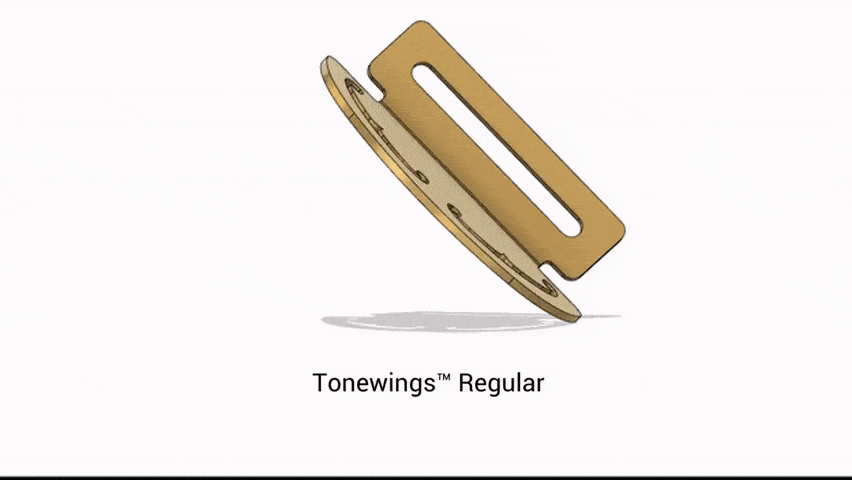
Click on title to watch full screen
